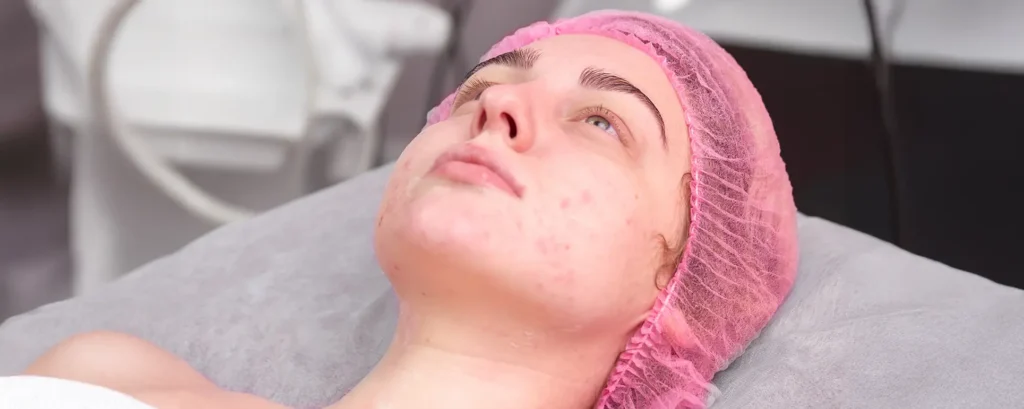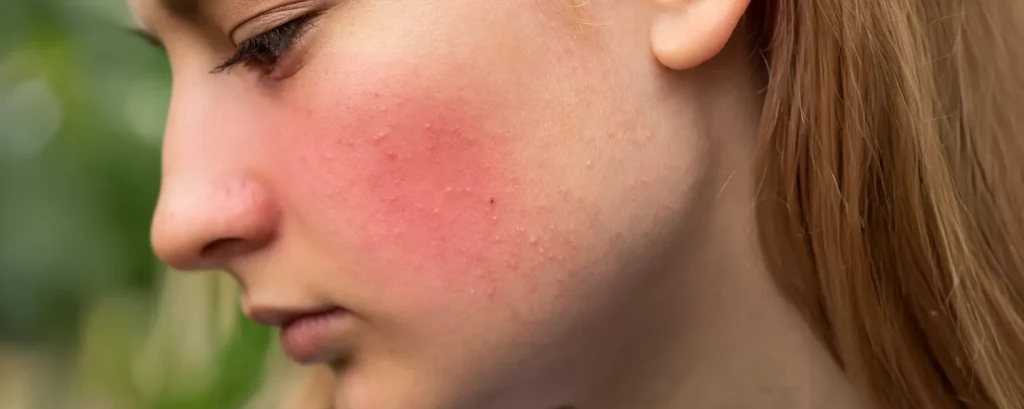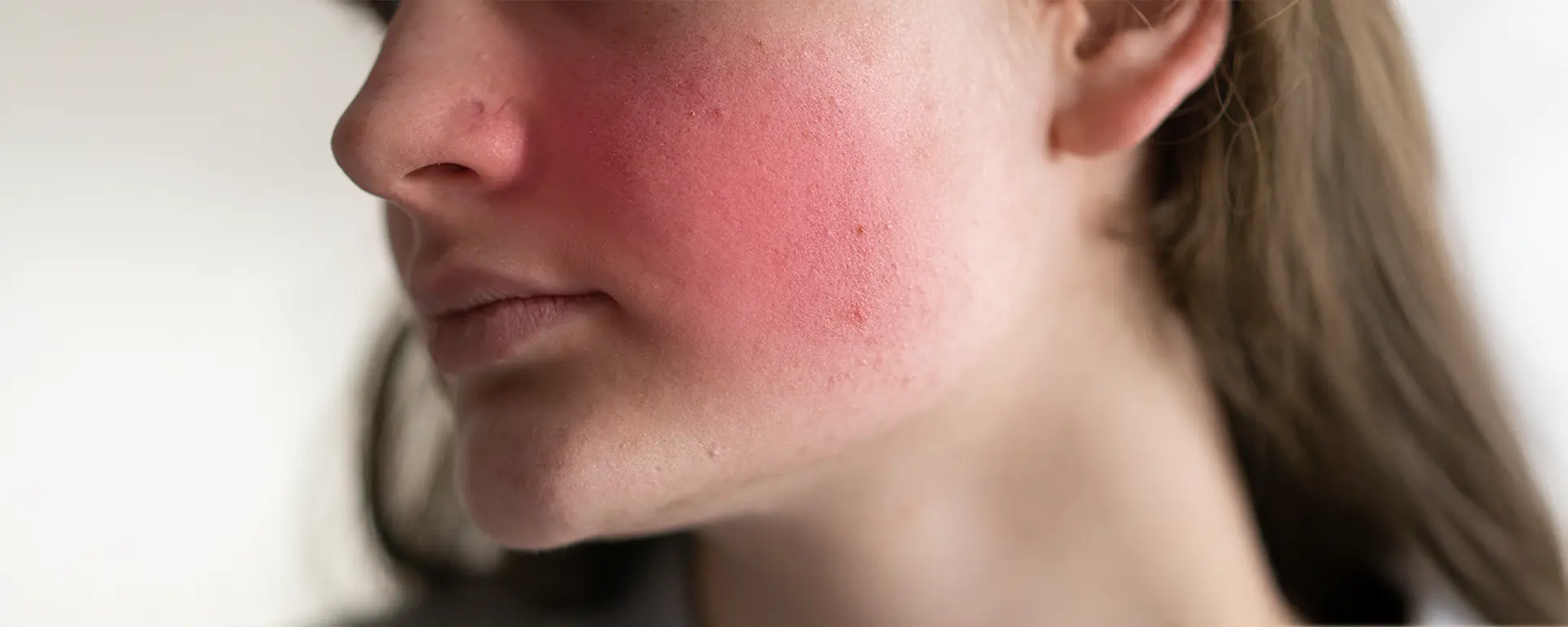We’ve all experienced facial redness at some point maybe after using a new skincare product, spending time in the sun, or stepping out into the cold. Often, this redness fades quickly and doesn’t cause much concern. But what if that redness becomes a regular occurrence? What if it flares up unpredictably, lasts for days, or seems to be getting worse over time?
If you’ve been wondering whether your skin is just a bit sensitive or if there’s something deeper going on, you’re not alone. Many people struggle to tell the difference between temporary irritation and signs of an underlying skin condition. And while the internet is full of DIY solutions, it’s not always easy to know which advice to trust or when it’s time to see a professional.
In some cases, persistent redness could be your skin’s way of signalling inflammation or an undiagnosed condition that needs medical attention. Left untreated, what starts as a mild flush can develop into something more serious, like rosacea, dermatitis, or even allergic reactions that disrupt your skin barrier.
In this article, I’ll walk you through the most common causes of persistent facial redness, explain how dermatologists assess and treat this issue, and explore the treatment options that can help bring your skin back into balance. Whether you’re dealing with occasional flushing or constant blotchiness, this guide will help you better understand what your skin is trying to tell you and what you can do to finally get some relief.
Common Causes of Facial Redness
Facial redness can be triggered by a range of conditions, and understanding the underlying cause is essential for choosing the right treatment. Here are the main culprits dermatologists encounter most often:
1. Rosacea

Rosacea is one of the most common causes of chronic facial redness, especially in adults over the age of 30. It’s a long-term inflammatory skin condition that primarily affects the central areas of the face, including the cheeks, nose, chin, and forehead. One of the hallmarks of rosacea is persistent redness that doesn’t fade, accompanied by small, visible blood vessels (called telangiectasia) and, in many cases, acne-like bumps or pustules. Some people may also experience thickening of the skin, especially around the nose, or eye irritation a form known as ocular rosacea.
Unlike temporary redness caused by sensitivity or irritation, rosacea is a medical condition that tends to get worse over time without appropriate care. It can be frustrating because the exact cause isn’t fully understood, but it’s thought to involve a combination of genetic, environmental, and immune system factors.
What makes rosacea particularly tricky is how easily it flares in response to common lifestyle and environmental triggers. These can include:
- Spicy foods
- Alcohol (especially red wine)
- Hot drinks like coffee or tea
- Sun exposure
- Cold weather or wind
- Heat or hot baths
- Emotional stress
- Certain skincare or cosmetic products
If you find that your skin flushes frequently, stays red for hours or days, or reacts strongly to heat, weather changes, or food, rosacea might be the underlying cause. And because it shares symptoms with acne or general sensitivity, it’s often misdiagnosed or misunderstood.
The good news? Dermatologists can diagnose rosacea accurately and offer targeted treatment options ranging from prescription creams and gels that reduce redness and inflammation to oral antibiotics or laser therapy for visible blood vessels. With the right skincare routine and trigger management, it’s possible to significantly reduce symptoms and restore a more even complexion.
2. Sensitive Skin
Some people are simply born with skin that’s more reactive than others. If your skin tends to flush easily, sting when you apply certain products, or become red in response to wind, heat, cold, or even touch, you might have sensitive skin. This isn’t necessarily a medical condition it’s more of a skin type. Sensitive skin is characterised by a reduced tolerance to external stimuli that most people wouldn’t even notice.
You may notice that your face reacts strongly to things like:
- Harsh cleansers or exfoliants
- Fragranced skincare or cosmetics
- Sudden changes in temperature
- Hot water or steam
- Rubbing or physical friction (even from a towel or face mask)
If your skin often feels tight, itchy, or burns after applying products even those labelled “gentle” this could be a tell-tale sign of sensitivity. The redness that appears with sensitive skin tends to be temporary and usually fades once the trigger is removed. Unlike conditions such as rosacea or eczema, there are typically no bumps, flaking, or long-lasting marks.
However, here’s the important part: sensitive skin can sometimes be a signal of something more going on beneath the surface. It could indicate a compromised skin barrier the protective layer that keeps moisture in and irritants out. When this barrier is weakened (often from over-exfoliating, using too many active ingredients, or environmental stressors), the skin becomes more vulnerable to redness and irritation.
Additionally, persistent sensitivity can overlap with or even mask underlying skin conditions like rosacea, contact dermatitis, or allergic reactions. That’s why it’s a good idea to get a dermatologist’s opinion if your skin is frequently red and reactive, even if you suspect it’s “just sensitive.”
A dermatologist can help determine whether your sensitivity is part of your natural skin type or a symptom of something that needs medical treatment. They can also recommend barrier-repairing products, fragrance-free skincare routines, and lifestyle adjustments to keep your skin calm, strong, and less reactive over time.
3. Seborrhoeic Dermatitis
Seborrhoeic dermatitis is another common cause of facial redness, and it often goes undiagnosed because it can mimic other conditions like eczema or even rosacea. It typically shows up as red, scaly, and sometimes greasy-looking patches on areas of the skin that have a high concentration of oil glands. These include the sides of the nose, eyebrows, forehead, hairline, and even the area behind the ears. It can also affect the scalp, leading to dandruff or flaking.
The condition is caused by an inflammatory response to a type of yeast called Malassezia, which naturally lives on the skin. In people with seborrhoeic dermatitis, the immune system seems to overreact to this yeast, resulting in ongoing redness, itching, flaking, and irritation. While the exact cause isn’t fully understood, a combination of genetic factors, skin oil production, and environmental triggers plays a role.
Seborrhoeic dermatitis tends to follow a chronic pattern, with periods of flare-ups followed by temporary improvement. Flare-ups can be triggered or worsened by:
- Cold, dry weather
- Stress or fatigue
- Hormonal changes
- Harsh skincare or haircare products
- A weakened immune system (it’s more common in people with certain medical conditions)
Unlike sensitive skin, which tends to come and go quickly, seborrhoeic dermatitis can persist for weeks or months if left untreated. The flaking may be mistaken for dry skin, but standard moisturisers often don’t help and may even make it worse if they contain irritating ingredients.
4. Allergic Reactions (Contact Dermatitis)

If you’ve recently changed your skincare routine, tried a new hair product, or even switched to a different laundry detergent and suddenly developed redness, itchiness, or irritation on your face, you could be dealing with a form of contact dermatitis. This condition occurs when your skin reacts to a substance that either irritates it or triggers an allergic response.
There are two main types of contact dermatitis:
- Irritant Contact Dermatitis: This is the more common form and results from direct damage to the skin’s outer layer by harsh substances. It doesn’t require an allergy just enough exposure to something irritating like alcohol-based products, exfoliating acids, or strong cleansers can lead to redness, dryness, stinging, and inflammation.
- Allergic Contact Dermatitis: This is a delayed immune reaction that occurs when your skin becomes sensitised to a specific ingredient. Common culprits include fragrances, preservatives (like parabens or formaldehyde releasers), dyes, essential oils, nickel (often found in eyelash curlers or jewellery), and even some botanical extracts that are marketed as “natural.”
In both cases, the skin may appear red, inflamed, itchy, and sometimes swollen. If the reaction is severe, you might even notice tiny blisters or peeling. On the face, allergic contact dermatitis often appears around the eyes, mouth, or where products were applied making it easy to mistake for eczema, rosacea, or just general sensitivity.
5. Lupus or Other Autoimmune Disorders
In rare cases, facial redness especially in the form of a distinct “butterfly rash” across the cheeks and the bridge of the nose may be a sign of an autoimmune condition like lupus. This rash often appears or worsens after sun exposure and can look flat or slightly raised. It’s not usually itchy, but it can persist for days or weeks.
Lupus is a systemic disease, meaning it can affect other parts of the body too. If your facial redness is accompanied by symptoms such as fatigue, joint pain, sensitivity to sunlight, or muscle aches, it’s worth getting checked by a healthcare professional. Other autoimmune conditions, like dermatomyositis or cutaneous lupus, can also cause red or purplish facial rashes.
Although this type of redness is far less common than rosacea or dermatitis, it’s important not to overlook it especially if your skin symptoms come with broader health issues. A dermatologist can help you determine whether your skin is pointing to something deeper and guide you toward the right tests and referrals if needed.
Why See a Dermatologist?
Trying to figure out the cause of facial redness on your own can be frustrating. With so many possible triggers ranging from mild sensitivity to chronic skin conditions or even autoimmune issues it’s easy to misdiagnose yourself or waste time (and money) on treatments that don’t work.
That’s where a dermatologist comes in. These skin specialists are trained to recognise the subtle differences between conditions that may look similar on the surface but require completely different approaches. What seems like a product reaction might actually be rosacea. Or what you assume is sensitive skin could be an early sign of seborrhoeic dermatitis or contact allergy.
Here’s what you can typically expect during a dermatology consultation:
- A detailed history of your symptoms, skincare routine, lifestyle, and any recent changes (like new products or medications)
- A visual examination of the affected areas, often under bright light or using a dermatoscope to assess surface patterns and blood vessels
- Patch testing to identify allergic reactions or contact sensitivities if suspected
- Skin swabs or a biopsy in more complex or persistent cases, to rule out infections or autoimmune causes
The goal is to get to the root of the problem not just manage the symptoms. A clear, accurate diagnosis allows for targeted treatment and a personalised skincare plan that actually works. And if your redness turns out to be linked to an internal condition, your dermatologist can coordinate with other specialists for holistic care.
In short, seeing a dermatologist can save you time, prevent unnecessary flare-ups, and help you feel more confident in your skin again.
Treatment Options That Work

The good news? Most causes of facial redness are treatable and many people see major improvements once the right diagnosis is made. The key is targeted care based on the specific condition affecting your skin. Here’s how dermatologists typically treat the most common causes:
For Rosacea:
Rosacea can’t be cured, but it can be managed very effectively with consistent care and trigger avoidance.
- Topical treatments such as metronidazole, azelaic acid, and ivermectin help reduce inflammation, redness, and acne-like breakouts.
- Oral antibiotics, especially doxycycline, are often prescribed for moderate to severe rosacea to calm more stubborn flare-ups.
- Laser therapy (like IPL or pulsed dye laser) can visibly reduce broken capillaries and persistent flushing when topical treatments aren’t enough.
For Sensitive Skin:
Managing sensitive skin involves protecting and repairing the skin barrier while avoiding harsh ingredients.
- Use gentle, fragrance-free skincare designed for reactive skin.
- Apply barrier repair creams with ceramides, niacinamide, or squalane to strengthen the skin and reduce inflammation.
- Avoid alcohol-based products, strong exfoliants, or anything that causes stinging or burning even if it’s marketed as “natural.”
For Seborrhoeic Dermatitis:
This condition responds well to antifungal and anti-inflammatory treatments that control yeast and reduce irritation.
- Use antifungal creams or shampoos, such as those containing ketoconazole, to reduce yeast activity.
- Apply low-strength steroid or anti-inflammatory creams during flare-ups to relieve redness and scaling.
- Keep the skin clean with gentle, non-irritating cleansers but avoid over-washing, which can disrupt the skin’s natural balance.
For Allergic Reactions:
The first step is identifying and removing the irritant or allergen from your routine.
- Immediately stop using the product or material causing the reaction.
- Apply topical steroid creams to reduce redness, itching, and inflammation.
- If itching is intense, oral antihistamines can help calm the immune response and prevent scratching.
For Autoimmune Causes:
Since these conditions often go beyond the skin, they require medical supervision and a multidisciplinary approach.
- Your dermatologist may recommend a referral to a rheumatologist for specialised testing and systemic care.
- Immunosuppressive medications or antimalarials (like hydroxychloroquine) may be used to reduce internal inflammation.
- Practise strict sun protection, as UV exposure can worsen autoimmune skin rashes. Use soothing skincare to calm irritation and maintain moisture.
What You Can Do at Home
While seeing a dermatologist is the best way to get an accurate diagnosis and targeted treatment plan, there are several steps you can take at home to help soothe and prevent facial redness in the meantime. These small adjustments can make a big difference in calming irritation and protecting your skin barrier:
- Stick to lukewarm water when washing your face. Hot water can strip away natural oils and increase redness, especially if your skin is already sensitive or inflamed.
- Choose hypoallergenic, fragrance-free moisturisers designed for sensitive or reactive skin. These are less likely to trigger flare-ups and help lock in hydration without causing irritation.
- Apply a mineral-based sunscreen daily, even on cloudy days. Look for formulas containing zinc oxide or titanium dioxide, which are gentler on sensitive skin and offer strong protection without chemical filters.
- Avoid rubbing, exfoliating, or over-cleansing. These habits can damage your skin’s protective barrier and make redness worse. Stick to gentle patting motions and use a soft cloth or your hands to cleanse.
- Track your flare-ups and look for patterns. Keeping a simple journal of when your redness appears along with foods, weather, skincare products, or stress levels can help you identify and avoid common triggers.
These steps won’t replace professional care, but they can help stabilise your skin, reduce discomfort, and prevent your symptoms from worsening while you wait for an appointment or trial a new treatment.
Final Thought: Time to Get Answers, Not Just Cover-Ups
If your face stays red more often than not or gets worse with time it’s worth looking beyond sensitivity. Redness can be a symptom of many skin conditions, and a dermatologist can help pinpoint the real cause and offer long-term solutions.
You can get in touch with us to book a consultation with one of our expert dermatologists in London. A calm, confident complexion might just be a treatment plan away.
References:
- Steinhoff, M. & Schauber, J. (2017). Rosacea: a review. Dermato‑endocrinology, 9(1), e1361574. doi: 10.1080/19381980.2017.1361574.
A detailed overview of rosacea’s symptoms, triggers, and evidence-based treatments
Available at: https://www.tandfonline.com/doi/full/10.1080/19381980.2017.1361574 - Markey, A.R. et al. (2019). Topical treatments for rosacea: efficacy of metronidazole, azelaic acid and ivermectin. BMJ Evidence‑Based Medicine, January 2019.
A systematic review demonstrating 65–75% improvement rates with those topical therapies. Available at: https://www.ncbi.nlm.nih.gov/pmc/articles/PMC6853348/ - Akman, A.Y. & Dalgıç, B. (2023). Diagnosis and management of seborrhoeic dermatitis. Anais Brasileiros de Dermatologia, 98(4), 419–433.
Covers pathophysiology, diagnosis, and first-line antifungal and anti-inflammatory treatment approaches. Available at: https://pubmed.ncbi.nlm.nih.gov/362512367/ - Galizia, G., Belloni Fortina, A. & Semenzato, A. (2024). Seborrheic Dermatitis: From Microbiome and Skin Barrier Involvement to Emerging Approaches in Dermocosmetic Treatment. Cosmetics, 11(6), 208.
Discusses the interplay of skin microbiome, barrier dysfunction, and topical antifungal and dermocosmetic interventions. Available at: https://www.mdpi.com/2079-9284/11/6/208 cureus.com+2 - Frontiers in Immunology (Curtiss, P. et al.) (2022). A Systematic Review of the Progression of Cutaneous Lupus to Systemic Lupus Erythematosus.
Summarises progression rates and highlights the importance of monitoring cutaneous lupus for systemic involvement.
Available at: https://www.frontiersin.org/journals/immunology/articles/10.3389/fimmu.2022.866319/full
